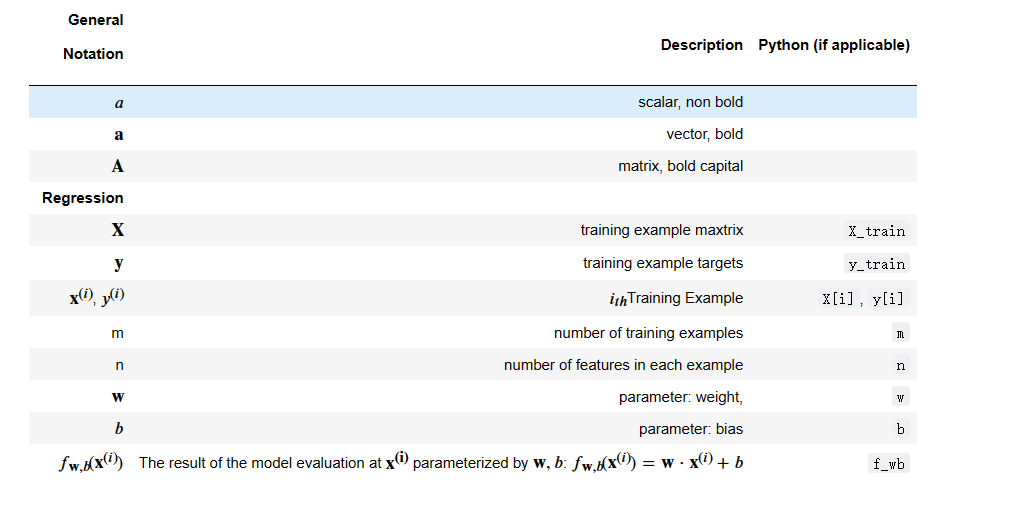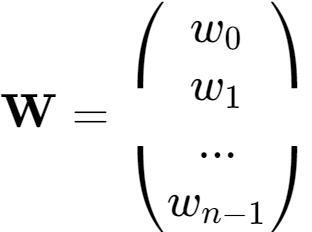多元线性回归
1、目标:
扩展我们的回归模型例程以支持多种功能
扩展数据结构以支持多种功能
重写预测、成本和梯度例程以支持多种功能
利用NumPy np.dot对其实现进行矢量化,以提高速度和简洁性
import copy, math
import numpy as np
import matplotlib.pyplot as plt
plt.style.use('./deeplearning.mplstyle')
np.set_printoptions(precision=2) # reduced display precision on numpy arrays

2、问题陈述
您将使用房价预测的激励示例。
训练数据集包含三个示例,下表显示了四个特征(大小、卧室、楼层和年龄)。
请注意,与早期的实验室不同,大小以平方英尺为单位,而不是 1000 平方英尺。这会导致一个问题,您将在下一个实验中解决该问题!
| 面积(平方英尺) | 卧室数量 | 层数 | 家庭年龄 | 价格 |
|---|---|---|---|---|
| 2401 | 5 | 1 | 45 | 460 |
| 1416 | 3 | 2 | 40 | 232 |
| 852 | 2 | 1 | 35 | 178 |
你将使用这些值建立一个线性回归模型,这样你就可以预测其他房子的价格。
例如,一栋1200平方英尺、3间卧室、1层楼、40年历史的房子。
请运行以下代码单元来创建X_train和y_train变量。
X_train = np.array([[2104, 5, 1, 45], [1416, 3, 2, 40], [852, 2, 1, 35]])
y_train = np.array([460, 232, 178])
2.1、包含我们示例的矩阵X
与上表类似,示例存储在NumPy矩阵X_train中。
矩阵的每一行代表一个例子。
当你有? 培训示例(? 在我们的例子中是三),并且有?特征(在我们的示例中为四个),
? 是一个具有维(? , ?)(m行,n列)。
?(?)是包含示例i的向量,?(?)=(?(?)0,?(?)1,⋯,?(?)?−1)
?(?)? 是示例i中的元素j。括号中的上标表示示例编号,而下标表示元素。
显示输入数据。
#数据存储在numpy数组/矩阵中
print(f"X Shape: {X_train.shape}, X Type:{type(X_train)})")
print(X_train)
print(f"y Shape: {y_train.shape}, y Type:{type(y_train)})")
print(y_train)
X Shape: (3, 4), X Type:<class 'numpy.ndarray'>)
[[2104 5 1 45]
[1416 3 2 40]
[ 852 2 1 35]]
y Shape: (3,), y Type:<class 'numpy.ndarray'>)
[460 232 178]
2.2、参数向量 w, b
w是一个向量 ?元素。
每个元素都包含与一个要素关联的参数。
在我们的数据集中,n 是 4。
从概念上讲,我们将其绘制为列向量。

?是一个标量参数。
# 为了演示,?和?将加载一些接近最优值的初始选定值。?是一个一维数字向
b_init = 785.1811367994083
w_init = np.array([ 0.39133535, 18.75376741, -53.36032453, -26.42131618])
print(f"w_init shape: {w_init.shape}, b_init type: {type(b_init)}")
w_init shape: (4,), b_init type: <class 'float'>
3、多变量模型预测
线性模型给出了具有多个变量的模型预测、矢量表示法:

3.1 、逐个元素的单一预测
我们之前的预测将一个特征值乘以一个参数,并添加一个偏差参数。
我们之前对多个特征的预测实现的直接扩展是实现上面的 (1) 在每个元素上使用循环,使用其参数执行乘法,然后在末尾添加偏差参数。
def predict_single_loop(x, w, b):
"""
single predict using linear regression
Args:
x (ndarray): Shape (n,) example with multiple features
w (ndarray): Shape (n,) model parameters
b (scalar): model parameter
Returns:
p (scalar): prediction
"""
n = x.shape[0]
p = 0
for i in range(n):
p_i = x[i] * w[i]
p = p + p_i
p = p + b
return p
# get a row from our training data
x_vec = X_train[0,:]
print(f"x_vec shape {x_vec.shape}, x_vec value: {x_vec}")
# make a prediction
f_wb = predict_single_loop(x_vec, w_init, b_init)
print(f"f_wb shape {f_wb.shape}, prediction: {f_wb}")
x_vec shape (4,), x_vec value: [2104 5 1 45]
f_wb shape (), prediction: 459.9999976194083
注意x_vec的形状。它是一个一维NumPy向量,包含4个元素(4,)。
结果f_wb是一个标量。
3.2、单一预测,向量
请注意,上述等式(1)可以使用上述(2)中的点积来实现。
我们可以利用向量运算来加速预测。
def predict(x, w, b):
"""
single predict using linear regression
Args:
x (ndarray): Shape (n,) example with multiple features
w (ndarray): Shape (n,) model parameters
b (scalar): model parameter
Returns:
p (scalar): prediction
"""
p = np.dot(x, w) + b
return p
#从我们的训练数据中获取一行
x_vec = X_train[0,:]
print(f"x_vec shape {x_vec.shape}, x_vec value: {x_vec}")
#作出预测
f_wb = predict(x_vec,w_init, b_init)
print(f"f_wb shape {f_wb.shape}, prediction: {f_wb}")
x_vec shape (4,), x_vec value: [2104 5 1 45]
f_wb shape (), prediction: 459.9999976194083
结果和形状与之前使用循环的版本相同。
np.dot将用于这些操作。
大多数例程将直接实现它,而不是调用单独的预测例程。
4、多变量的计算成本
多变量成本函数的方程?(?,?):

def compute_cost(X, y, w, b):
"""
compute cost
Args:
X (ndarray (m,n)): Data, m examples with n features
y (ndarray (m,)) : target values
w (ndarray (n,)) : model parameters
b (scalar) : model parameter
Returns:
cost (scalar): cost
"""
m = X.shape[0]
cost = 0.0
for i in range(m):
f_wb_i = np.dot(X[i], w) + b #(n,)(n,) = scalar (see np.dot)
cost = cost + (f_wb_i - y[i])**2 #scalar
cost = cost / (2 * m) #scalar
return cost
# Compute and display cost using our pre-chosen optimal parameters.
cost = compute_cost(X_train, y_train, w_init, b_init)
print(f'Cost at optimal w : {cost}')
Cost at optimal w : 1.5578904428966628e-12
预期成果: 最佳成本 w : 1.5578904045996674e-12
5、具有多个变量的梯度下降
5.1、使用多个变量计算梯度
def compute_gradient(X, y, w, b):
"""
Computes the gradient for linear regression
Args:
X (ndarray (m,n)): Data, m examples with n features
y (ndarray (m,)) : target values
w (ndarray (n,)) : model parameters
b (scalar) : model parameter
Returns:
dj_dw (ndarray (n,)): The gradient of the cost w.r.t. the parameters w.
dj_db (scalar): The gradient of the cost w.r.t. the parameter b.
"""
m,n = X.shape #(number of examples, number of features)
dj_dw = np.zeros((n,))
dj_db = 0.
for i in range(m):
err = (np.dot(X[i], w) + b) - y[i]
for j in range(n):
dj_dw[j] = dj_dw[j] + err * X[i, j]
dj_db = dj_db + err
dj_dw = dj_dw / m
dj_db = dj_db / m
return dj_db, dj_dw
#Compute and display gradient
tmp_dj_db, tmp_dj_dw = compute_gradient(X_train, y_train, w_init, b_init)
print(f'dj_db at initial w,b: {tmp_dj_db}')
print(f'dj_dw at initial w,b: \n {tmp_dj_dw}')
dj_db at initial w,b: -1.6739251501955248e-06
dj_dw at initial w,b:
[-2.73e-03 -6.27e-06 -2.22e-06 -6.92e-05]
预期成果: 初始 w,b 时的dj_db:-1.6739251122999121e-06 初始 w,b 时的
dj_dw:
[-2.73e-03 -6.27e-06 -2.22e-06 -6.92e-05]
5.2、多变量梯度下降
下面的例程实现了上面的等式(5)。
def gradient_descent(X, y, w_in, b_in, cost_function, gradient_function, alpha, num_iters):
"""
执行批量梯度下降以学习θ。通过获取更新theta带学习率alpha的num_iters梯度步长
X(ndarray(m,n)):数据,具有n个特征的m个示例
y(ndarray(m,)):目标值
w_in(ndarray(n,)):初始模型参数
b_in(标量):初始模型参数
cost_function:计算成本的函数
gradient_function:计算梯度的函数
alpha(浮动):学习率
num_iters(int):运行梯度下降的迭代次数
退货:
w(ndarray(n,)):更新的参数值
b(标量):参数的更新值
"""
# An array to store cost J and w's at each iteration primarily for graphing later
J_history = []
w = copy.deepcopy(w_in) #avoid modifying global w within function
b = b_in
for i in range(num_iters):
# Calculate the gradient and update the parameters
dj_db,dj_dw = gradient_function(X, y, w, b) ##None
# Update Parameters using w, b, alpha and gradient
w = w - alpha * dj_dw ##None
b = b - alpha * dj_db ##None
# Save cost J at each iteration
if i<100000: # prevent resource exhaustion
J_history.append( cost_function(X, y, w, b))
# Print cost every at intervals 10 times or as many iterations if < 10
if i% math.ceil(num_iters / 10) == 0:
print(f"Iteration {i:4d}: Cost {J_history[-1]:8.2f} ")
return w, b, J_history #return final w,b and J history for graphing
#初始化参数
initial_w = np.zeros_like(w_init)
initial_b = 0.
#一些梯度下降设置
iterations = 1000
alpha = 5.0e-7
#运行梯度下降
w_final, b_final, J_hist = gradient_descent(X_train, y_train, initial_w, initial_b,
compute_cost, compute_gradient,
alpha, iterations)
print(f"b,w found by gradient descent: {b_final:0.2f},{w_final} ")
m,_ = X_train.shape
for i in range(m):
print(f"prediction: {np.dot(X_train[i], w_final) + b_final:0.2f}, target value: {y_train[i]}")
Iteration 0: Cost 2529.462023-03-22 15:42:47 星期三
Iteration 100: Cost 695.99
Iteration 200: Cost 694.92
Iteration 300: Cost 693.86
Iteration 400: Cost 692.81
Iteration 500: Cost 691.77
Iteration 600: Cost 690.73
Iteration 700: Cost 689.71
Iteration 800: Cost 688.70
Iteration 900: Cost 687.69
b,w found by gradient descent: -0.00,[ 0.2 0. -0.01 -0.07]
prediction: 426.19, target value: 460
prediction: 286.17, target value: 232
prediction: 171.47, target value: 178
预期成果: 通过梯度下降得到的 b,w:-0.00,[ 0.2 0. -0.01 -0.07]
预测: 426.19,目标值:460 预测:286.17,目标值:232
预测:171.47,目标值:178
#绘图成本与迭代
fig, (ax1, ax2) = plt.subplots(1, 2, constrained_layout=True, figsize=(12, 4))
ax1.plot(J_hist)
ax2.plot(100 + np.arange(len(J_hist[100:])), J_hist[100:])
ax1.set_title("Cost vs. iteration"); ax2.set_title("Cost vs. iteration (tail)")
ax1.set_ylabel('Cost') ; ax2.set_ylabel('Cost')
ax1.set_xlabel('iteration step') ; ax2.set_xlabel('iteration step')
plt.show()
